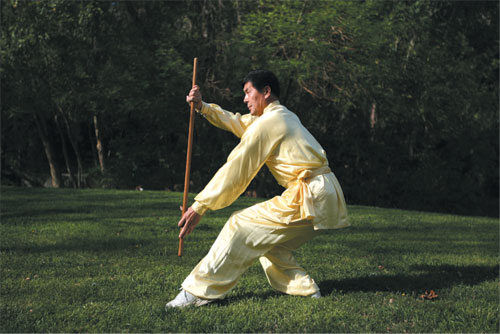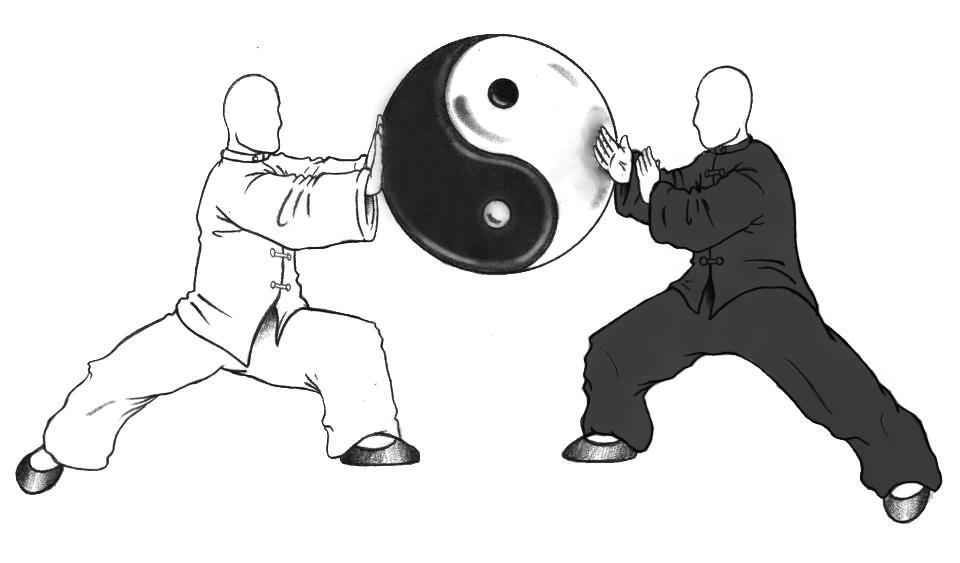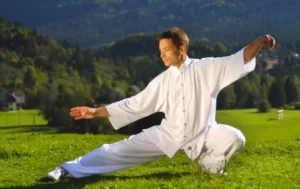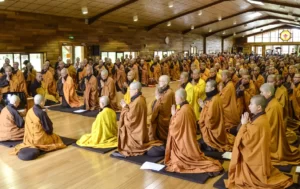Martial Qigong is a cornerstone of traditional Chinese martial arts, represents a fascinating amalgamation of physical discipline, energy cultivation and spiritual enlightenment.
Drawing upon the core principles of Qigong, Martial Qigong focuses on the flow of Qi—vital energy within the body—to enhance physical prowess, mental clarity, and martial skills. It incorporates techniques of regulated breathing, meditative focus, and deliberate movements, all aimed at stimulating and harmonizing the Qi.
What is Martial Qigong?
Martial Qigong is an essential branch of Traditional Chinese Medicine that combines movement, meditation, and regulated breathing to enhance the flow of Qi (vital energy) in the body. This discipline, part of the larger Qigong family, has been practiced for centuries as a means of cultivating physical strength, mental clarity, and spiritual awareness.
While the primary focus of Qigong is health maintenance and healing, Martial Qigong specifically concentrates on enhancing physical prowess and martial skills. It does so by encouraging the smooth and efficient flow of Qi, thus ensuring optimal functionality of the practitioner’s body. Such an optimal flow of energy is believed to provide the practitioner with a wide range of benefits, including improved stamina, enhanced agility and increased physical power.
Martial Qigong is often integrated into traditional Chinese martial arts training regimens, including Kung Fu and Tai Chi. By concentrating on their inner energy, practitioners of Martial Qigong are able to cultivate a deep connection between mind, body, and spirit—an integral aspect of any martial discipline.
Additionally, Martial Qigong encourages practitioners to develop a deeper understanding of their physical selves. This, in turn, assists in improving their martial technique, as they become more aware of their bodies’ capabilities and limitations. This awareness also contributes to a heightened perception of their environment, which is vital in martial arts.
History of Martial Qigong
The history of Martial Qigong is deeply entwined with the cultural, philosophical, and medicinal history of China. Tracing its origins back over 4,000 years, Martial Qigong is a product of the continuous development of Traditional Chinese Medicine, Daoist philosophical concepts and martial arts.
The early roots of Martial Qigong can be found in ancient Daoist exercises that focused on breath control and meditation, designed to cultivate Qi and promote longevity. As these practices evolved, they incorporated physical movements, forming a unique blend of physical activity and meditation that we know as Qigong.
The application of Qigong in martial arts is believed to have begun during the Zhou Dynasty (1046–256 BCE), when it was integrated into archery and chariot racing. It was not until the advent of the Han Dynasty (206 BCE–220 CE), however, that Qigong began to influence hand-to-hand combat techniques.
This integration of Qigong into martial arts deepened with the establishment of the Shaolin Temple in the 5th century CE. Monks at this temple began practicing Qigong exercises not only to improve their health and spiritual growth, but also to enhance their martial arts skills. This gave birth to Martial Qigong as a distinct discipline.
Over centuries, the practice of Martial Qigong was refined and developed further. During the Tang Dynasty (618–907 CE), Martial Qigong was incorporated into military training. This era also witnessed the systematization of Martial Qigong exercises, often depicted in detailed manuscripts and stone carvings.
Martial Qigong continued to evolve, and by the Ming Dynasty (1368–1644 CE), the connection between martial arts, Traditional Chinese Medicine, and Qigong became even more profound. This era witnessed the creation of several important texts on Qigong and martial arts, notably the “Classic of Boxing” and the “Canon of the Fist.”
In the modern era, Martial Qigong has not only remained a vital part of martial arts training in China, but it has also spread globally. It is now practiced worldwide as a means of enhancing martial abilities, improving health and promoting mental clarity.
Some basic Martial Qigong exercises for beginners
Practicing Martial Qigong involves a series of exercises that emphasize the cultivation and control of vital energy, improvement of physical strength, and enhancement of mental clarity. For beginners, the focus should be on mastering foundational exercises before progressing to more complex techniques.
- Standing Meditation (Zhan Zhuang): This form of Qigong exercise is essentially a standing meditation where the practitioner maintains a specific posture for a period of time. The aim is to cultivate inner stillness and awareness, as well as to build strength and endurance. In a typical Zhan Zhuang exercise, the practitioner stands with feet shoulder-width apart, knees slightly bent, arms raised as if holding a large ball, and the body relaxed.
- The Horse Stance (Ma Bu): The Horse Stance is another foundational exercise in Martial Qigong. The practitioner stands with feet wider than shoulder-width apart, as if straddling a horse, with knees bent and back straight. This stance is held for as long as comfortable, building leg strength, stability and endurance.
- Breathing Exercises (Qigong Tu Na): Proper breathing is a fundamental aspect of Martial Qigong. A common exercise is abdominal breathing, where the practitioner learns to breathe deeply, expanding the abdomen on inhalation and contracting it on exhalation. The aim is to enhance lung capacity, control the breath, and facilitate the flow of Qi.
- The Eight Pieces of Brocade (Ba Duan Jin): This set of exercises includes eight separate movements, each focusing on a different physical area and Qi meridian. For beginners, these exercises provide an excellent introduction to the movement and control of Qi in the body. The Eight Pieces of Brocade includes movements such as “Two Hands Hold up the Heavens,” which stretches the body and regulates the “Triple Warmer” meridian, and “Drawing the Bow to Shoot the Eagle,” which exercises the arms, shoulders, and legs while also stimulating various acupoints.
- Five Animal Play (Wu Qin Xi): This ancient exercise imitates the movements of five animals—the tiger, deer, bear, monkey, and bird. Each animal movement offers different physical and energetic benefits. For instance, the tiger movement is designed to enhance strength and Qi flow, while the deer movement aims to improve grace and flexibility.
Each of these exercises serves as a fundamental building block in the practice of Martial Qigong. As you advance, you can incorporate more complex movements and techniques. But you have to remember that like any physical regimen, consistency is key. Practicing these exercises regularly will yield greater benefits in terms of physical strength, mental clarity and flow of Qi.
Benefits associated with practicing Martial Qigong
The practice of Martial Qigong is associated with a multitude of benefits, which extend across the physical, mental, and spiritual realms. These benefits stem from the primary goal of Qigong, which is the cultivation and balanced circulation of Qi within the body.
- Enhanced physical strength and stamina: The physical exercises in Martial Qigong build muscular strength and endurance. This is particularly important for martial artists who require physical prowess in their training and performance. Regular practice can lead to improved physical fitness, including increased agility and flexibility.
- Improved energy flow: Martial Qigong focuses on the cultivation and control of Qi, the body’s vital energy. Practitioners learn to guide this energy through their bodies, which can lead to improved vitality and a sense of wellness. This optimal energy flow is also believed to promote the body’s self-healing capabilities, potentially improving overall health.
- Mental clarity and focus: Through meditative exercises and regulated breathing, Martial Qigong can help enhance mental clarity and concentration. This mental acuity is critical in martial arts where focus and quick decision-making are vital.
- Stress reduction and emotional balance: The meditative component of Martial Qigong promotes relaxation and stress reduction. By cultivating a calm mind, practitioners can achieve emotional balance, which is beneficial in handling daily life stresses and challenges.
- Enhanced martial skill: For martial artists, Martial Qigong can provide a significant enhancement to their martial abilities. By developing a deeper understanding of their energy and body, practitioners can improve their technique, speed and power.
- Spiritual growth: The spiritual dimension of Martial Qigong should not be underestimated. Through continuous practice, practitioners can cultivate a deeper sense of self-awareness and connectedness, contributing to personal growth and development.
How does Martial Qigong differ from traditional Qigong?
While all forms of Qigong involve the regulation of the body, breath, and mind, distinctions arise when one considers specific variations such as Martial Qigong.
Traditional Qigong primarily focuses on health maintenance, healing, and spiritual cultivation. It integrates posture, movement, breathing technique, self-massage, sound, and focused intent to promote the flow of Qi, aiming to foster overall health, vitality, and tranquility. Various forms of traditional Qigong exercises, such as the Eight Pieces of Brocade or Five Animal Frolics, have been designed to stimulate specific meridian systems and organs within the body, contributing to the harmonization of energy and the maintenance of physical wellbeing.
On the other hand, Martial Qigong while also promoting health and spiritual growth, has a distinct emphasis on the enhancement of martial abilities. In addition to regular Qigong practices, it includes exercises specifically designed to increase physical power, speed, flexibility, balance, and resilience—qualities essential in martial arts. For instance, the Iron Shirt Qigong form, a subset of Martial Qigong, is designed to develop a protective ‘energy shield,’ increasing the body’s resistance to strikes and blows.
Moreover, Martial Qigong exercises often incorporate specific martial stances, movements, and mental imagery, all aimed at improving martial technique and performance. The cultivation of a keen sense of body awareness and Qi flow becomes instrumental not only in executing martial techniques effectively but also in avoiding injury.
Martial Qigong centers around the world
Martial Qigong, a cornerstone of traditional Chinese martial arts, has found its way into various corners of the globe. This worldwide distribution is facilitated by Martial Qigong centers—places dedicated to teaching and practicing this unique discipline. Here are a few notable centers around the world:
- The International Institute of Medical Qigong (USA): Founded by Dr. Jerry Alan Johnson, one of the West’s leading authorities on Medical Qigong, this institute offers comprehensive courses in Medical and Martial Qigong. It operates in various locations across the United States and internationally.
- Shaolin Temple UK (United Kingdom): Affiliated with the Shaolin Temple in Henan, China, this center in London offers classes in Martial Qigong as part of its comprehensive curriculum in Shaolin Kung Fu and traditional Shaolin cultural arts.
- Beijing Traditional Medical Exchange (China): Based in the capital city of Beijing, this center offers programs in traditional Chinese medicine, Qigong, and Martial Qigong. Its location provides students with an opportunity to immerse themselves in the birthplace of these practices.
- International Qigong Foundation for Social Oncology (Japan): This unique institution in Japan utilizes Qigong, including its martial component, as an integral part of holistic care for cancer patients.
- The Chi Center (Australia): Located in Brisbane, the Chi Center offers Qigong and Tai Chi classes, including Martial Qigong, to promote health and wellbeing. The center aims to provide a peaceful environment for the practice and understanding of these traditional arts.
- The Qigong Institute (Brazil): This institute offers classes in Qigong and Tai Chi, including their martial forms, promoting these practices in South America. Its mission is to spread the benefits of these disciplines and contribute to the well-being of its practitioners.
Each of these centers, located in different parts of the world, contributes to the preservation, dissemination, and evolution of Martial Qigong. They all offer practitioners the opportunity to delve into the intricacies of Martial Qigong, learning from experienced instructors while also engaging with a community of like-minded individuals.











